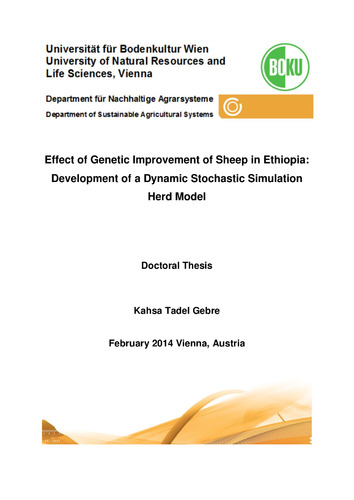Effect of genetic improvement of sheep in Ethiopia: Development of a dynamic stochastic simulation herd model
Abstract
A community-based sheep breeding program has been implemented in the highlands of Ethiopia to improve the body weight and reproductive performance of Menz sheep. This study adopts system dynamic methodology to develop a dynamic stochastic simulation herd model to evaluate the effect of genetic improvement and additional feed sources (forage production) on herd dynamics and profitability. The study also explores the opportunities of system dynamics approach in the context of designing breeding programs to predict annual genetic gain of traits. Historical data of monthly rainfall for a period of 10 years and 4 years of monthly temperature data were used. Sheep performance data were available from the herd-book of the community-based sheep breeding program. Additional input data were sourced from questionnaires, observation, literature and expert knowledge. The simulation model consists of three sub-models: vegetation growth and dynamics, herd structure and dynamics and economic analysis. The length of the time horizon was 240 months (20 years). The first 120 months served as a baseline scenario, where the fattening of culled breeding rams was practiced. For the second 120 months genetic selection of body weight was introduced considering two scenarios: culled ram and lamb fattening. For the prediction of genetic gain genetic selection for six month weight, pre-weaning survival and fertility rate was introduced from the initial stage of the simulation. Results from the model showed a gradual decrease in sheep population size while body weight of the animals improved. The model keeps heavier animals in smaller flocks to match the herd nutritional demand with the available resources. The simulation also demonstrates that breeding for heavier body weight was considerably more profitable than the baseline scenario; and lamb fattening was more profitable than culled ram fattening, which is the current practice. Smallholder farmers can gain more income by fattening young lambs due to a decrease of production (health, housing and labour) and feed costs compared to fattening of culled breeding ram. A reasonable annual genetic gain, rate of inbreeding and profit per ewe per year were predicted when community based breeding is performed. System dynamics modelling is a valuable tool to describe breeding programs by building a simple, flexible and usage driven simulation model. Results of the simulations were discussed on site with smallholder farmers and they are willing to reduce flock size in order to have healthy, fast growing animals. Further development and evaluation of the model is needed which shall lead to further refinement. This shall eventually aid in the further evaluation of genetic selection in the Menz sheep population, helping smallholder farmers to increase income.

